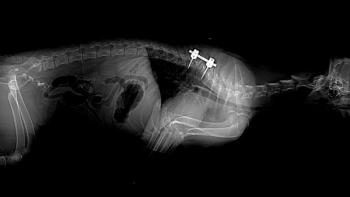
Traumatic spinal cord injury (Proceedings)
Traumatic spinal cord injury.
• Primary injury
o Direct parenchymal and vascular damage
o Occurs immediately as a result of traumatic event
• Secondary injury
o Result of biochemical cascades initiated by primary injury
o Includes ATP depletion, increases in intracellular Na+ and Ca2+ as well as extracellular excitatory neurotransmitters, production of oxygen free radicals, increased cytokine production, accumulation of nitric oxide, lactic acidosis and activation of arachidonic acid, kinin, complement, coagulation and fibrinolytic cascades
o Results in further damage to nervous tissue
o Therapy directed at minimizing secondary injury
• Initial neurologic evaluation
o Important components of neurologic exam
▪ Motor/Posture – ambulatory vs. recumbent, muscle tone and voluntary movements, Schiff-Sherrington posture
▪ Segmental reflexes – tendon, withdrawal, panniculus and perineal reflexes
▪ Pain perception – assessed via behavioral response to a noxious stimulus
» Superficial – elicited from pinch of the skin/SQ tissues
» Deep – elicited from pinch of bone/digit
▪ Mentation and cranial nerve evaluation can generally be performed without significant patient manipulation
o Scoring system has been described for acute spinal cord injury in dogs
o Initial neurologic status may improve following immediate stabilization
• Management of TSCI
o Immobilization
o Hemodynamic stabilization
▪ Resuscitation for maintenance of normotension, adequate oxygen levels
» Often concurrent injuries involving other areas – cardiovascular, respiratory, abdominal, brain trauma
▪ CBC, chemistry panel, electrolytes, UA and thoracic radiographs can help define extent of injuries
o Analgesia
o Imaging
▪ Radiographs – screening lateral views safe; VD views only with a horizontal beam technique if potential for instability exists
▪ CT – excellent bone detail, evidence of hemorrhage may be seen
▪ Myelography – used to evaluate potential spinal cord compression
▪ MRI – for evaluation of extrinsic and intrinsic spinal cord lesions
o Medical management to reduce secondary injury
▪ Corticosteroids
» Use controversial in human and veterinary medicine
» Methylprednisolone has been extensively evaluated; evidence suggests benefit related more to free radical scavenging than anti-inflammatory properties; other commonly used steroids (e.g. prednisone, dexamethasone) do not have free radical scavenging capabilities
» National Acute Spinal Cord Injury Study trials in humans
o Small improvements (in motor scores at 6 weeks and pinprick and touch sensation at 6 months post injury) noted in TSCI patients administered methylprednisolone within 8 hours of injury; detrimental >8h; no difference in outcome vs. control groups at 1 year; increased risk of pneumonia and trend towards sepsis with methylprednisolone therapy
» A study in dogs showed timely surgical decompression of acute compressive spinal cord injury was more effective for improving neurologic recovery than methylprednisolone without surgery
» A study of dachshunds administered methylprednisolone and having surgical decompression following IVD herniation showed increased post-operative complications (melena, diarrhea, emesis, hematemesis and anorexia) and higher medical bills vs. dogs not receiving methylprednisolone Polyethylene glycol (PEG)
» Use shown to be safe in dogs
» Ongoing studies for evaluation of efficacy in spinal cord injury
▪ N-acetylcysteine has been investigated to prevent oxidative secondary injury in dogs, but did not prove to have clinical benefit in a randomized blinded placebo-controlled clinical trial
o Management of vertebral instability/fractures/luxation
▪ Non surgical treatment
»Similar long term outcomes vs. surgery in several retrospective studies
» Confinement – mandatory for suspected instability, =6 weeks
▪ External support – for immobilization of vertebral segments cranial and caudal to lesion; variably tolerated from patient to patient
» Potentially less expensive vs. surgical therapy, but more labor intensive, longer recovery and potentially a greater risk of persistent deficits
▪ Surgical decompression/stabilization
» Indications include minimal voluntary movement, evidence of highly unstable fractures and progression of signs despite appropriate non surgical treatment
» A variety of methods of stabilization have been reported
▪ Oscillating electric field – has shown some initial promise in dogs with complete transverse myelopathy
▪ Low level laser therapy also being investigated in dogs
o Prognosis and complications
▪ Prognosis for return of function with loss of deep pain perception generally considered grave; in one study of cervical vertebral fractures in dogs, severity of neurological deficits (nonambulatory status) and prolonged interval (five days or longer) from trauma to referral were associated with poorer outcome
▪ Persistent neurologic deficits possible
▪ Hypoventilation possible with cervical trauma/surgery
▪ Myelomalacia possible in association with of loss of pain perception
▪ Additional complications of recumbent patients, including aspiration pneumonia, UTI, pressure sores
Suggested reading:
Spinal Fracture or Luxation, Bagley, RS, The Veterinary Clinics of North America: Small Animal Practice, Common Neurologic Problems, 30(1), 2000
Bracken MB et al, A randomized, controlled trial of methylprednisolone or naloxone in the treatment of acute spinal cord injury. Results of the Second National Acute Spinal Cord Injury Study. N Engl J Med, 1990; 322(20):1405-1411
Newsletter
From exam room tips to practice management insights, get trusted veterinary news delivered straight to your inbox—subscribe to dvm360.




